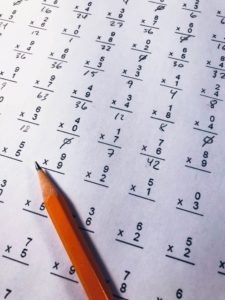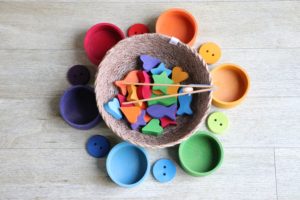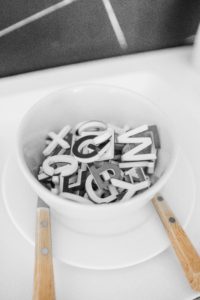This month, like clockwork, our High Five Highlights magazine came in the mail for our three-year-old. He absolutely loves getting these magazines in the mail and sitting down with me to look them over. There are so many great features, but one of his absolute favorites is the Hidden Picture page, where he is challenged to find certain objects that are hidden among a busy picture scene.
This got me thinking about all of the benefits that matching has in terms of language and learning and even inspired me to create some fun autumn-themed material that is AVAILABLE FOR PURCHASE HERE!
| Table of Contents |
|---|
| Why is Matching Important? |
| When Should I Introduce Matching to My Child? |
| Let’s Water the Sponge! 5 Matching Activity Ideas |
Why is Matching Important?
Concepts. Matching is a great way to tie together concepts such as colors, shapes, numbers, and more. For example, if you are and your little one are matching socks, then you can link matching with colors. A green sock does not match with a blue sock, just as a striped sock does not match with a polka-dot sock (okay, I hear you, maybe the washing machine consumed your socks again and you are forced to make mismatched pairs!) You catch my general drift, though, that matching is directly linked to rudimentary concepts.
Language. You can use this as an opportunity to explain why and how something matches, or how it is different. Use matching to introduce new concepts to your child. If your child brings you a green sock and a blue sock, then you can tell him, “These are both socks, but one is green and the other is blue. They are different colors. Let’s go find the other green sock that is the same.”

Math. Having the ability to match does not only impact language, but math skills as well. In math, children need to be able to identify patterns, match numbers with their assigned value, and match equations with appropriate graphs.
Memory. Practicing matching skills is linked with improved memory, particularly working memory, which is incredibly important when it comes to decoding. Children must be able to remember the sounds that the letters make when decoding (e.g., “d”-“o”-“g”) then blend the sounds together to correctly read the word. If the child forgets the first sound or is unable to correctly match the letter with the sound, then he will not read the word accurately.
Visual Discrimination. Matching boosts children’s ability to visually discriminate between objects. Visual Discrimination is the ability to tell the difference between items. This is a particularly important skill when it comes to early literacy. Children who struggle with visual discrimination, especially objects with subtle differences, oftentimes have difficulty with letters and sounds later on. For instance, the letters “p” and “b” might appear to be similar, or “b” and “d” might seem the same to these kiddos. Working on matching skills will help lay the foundation for visual discrimination, which in turn will aid in boosting early literacy skills.
All of these skills start with the ability to match, so let’s chat a bit about when it is best to teach your child about matching.
When Should I Introduce Matching to my Child?
As with many skills and concepts, my personal opinion is the earlier the better! Matching takes a variety of forms, so you can introduce some components of matching earlier than others.
I started working on matching shapes with my children when they could sit up and complete short tasks, around 6-months-old. They were not able to match the shapes independently, but I started the conversation from a young age. I talked about colors and shapes and counted the sides of triangles versus squares versus stars.

That being said, it takes a bit of time before children piece all of the information together and act on it. My nineteen-month-old has only recently begun to match shapes within the past few weeks. As you can see, that is a lot of groundwork to lay between 6 months and 19 months!
With both of my boys, I started teaching them how I fold laundry and match socks when they were about a year old. My oldest seemed much more interested in that task than my youngest, so a lot depends on your child and his personality!
Keep reading to learn more about different kind of matching tasks!
Let’s Water the Sponge!
5 Matching Activity Ideas:
1.) Matching on the white board. There are endless possibilities on a whiteboard! You can practice matching letters or colors.
If you are working on letters, go ahead and separate the board into two separate columns. As an example, at the top of one column write the letters Bb and the letters Mm at the top of the other. Give the child pictures of objects and have him sort the pictures into the Bb or Mm column accordingly. For example, you could hand your child a picture of a bush and have him put it under the Bb column on the whiteboard.
2.) Making a mess of shoes and matching them. This is a great task for little kids! Both of our boys really enjoyed making a mess of shoes – our youngest still does. You can turn this into a matching activity by selecting several pairs of shoes and putting them into a pile on the floor. Have your child match the shoes into pairs and then put them where they belong.

3.) Matching colors to construction paper. For this task, you can take different colors of construction paper and go around your house and collect objects that are those colors. For instance, you can target the colors yellow and green. Hunt for 3-5 objects that are these colors, then place them in front of you child and have him sort the objects onto the colored construction paper accordingly.
4.) Matching food in pantry to correct category. Go ahead and let your little one play around with some pantry foods! Gather some spices, dried goods, canned goods, etc., and have your little one sort foods by category. If you want to, you can take this activity one step further by letting your child feel and (maybe, if appropriate) taste the food that you present her with.
5.) Matching objects with correct first letter sound using sticky-notes. Select a sound to target for the week or day, let’s pretend it’s Nn. Grab a stack of sticky-notes and write the letters Nn on a dozen or so. Walk around the house with your child and see if your child can figure out what objects begin with Nn in your house! Offer as much support as needed (e.g., offer two choices – “Does nightstand or book start with ‘n?'”) If your child grasps the concept readily, see if he can catch your errors (e.g., put a sticky note on T-shirt and see if he can tell you that what you did is incorrect.)
What have you done at home lately to practice matching? If you need a fresh idea, feel free to purchase my Autumn Matching Packet! Go ahead and drop some of your ideas below!



